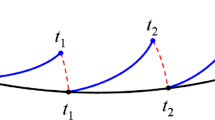Abstract
Atmospheric drag is the main source of error in the determination and prediction of the orbit of low Earth orbit (LEO) satellites; however, empirical models that are used to account for this often have density errors of around 15%–30%. Atmospheric density determination has thus become an important topic for researchers. Based on the relationship between the atmospheric drag force and the decay of the semi-major axis of the orbit, we derived atmospheric density along the trajectory of challenging mini-satellite payload (CHAMP) satellite with its rapid science orbit (RSO) data. Three primary parameters—the ratio of cross-sectional area to mass, the drag coefficient, and the decay of the semi-major axis caused by atmospheric drag—were calculated. We also analyse the source of the error and made a comparison between the GPS-derived and reference density. The result for December 2, 2008, showed that the mean error of the GPS-derived density could be decreased from 29.21% to 9.20%, if the time span adopted for the process of computation was increased from 10 min to 50 min. The result for the entire month of December indicated that a density precision of 10% could be achieved, when the time span meets the condition that the amplitude of the decay of the semi-major axis is much greater than its standard deviation.
Similar content being viewed by others
References
Jacchia L. New Static Models of the Thermosphere and Exosphere with Empirical Temperature Profiles. SAO Special Report #313, 1970
Hedin A E. MSIS-86 thermospheric model. J Geophys Res, 1987, 92: 4649–4662
Picone J M, Hedin A E, Drob D P, et al. NRLMSISE-00 empirical model of the atmosphere: Statistical comparisons and scientific issues. J Geophys Res, 2002, 107: SIA 15–1–SIA 15–16
Bowman B R, Kent Tobiska W, Marcos F A, et al. The JB2006 empirical thermospheric density model. J Atmos Sol-Terrestrial Phys, 2008, 70: 774–793
Storz M F, Bowman B R, Branson M J I, et al. High accuracy satellite drag model (HASDM). Adv Space Res, 2005, 36: 2497–2505
King-Hele D G. Methods of determining air density from satellite orbits. Ann Geophys, 1966, 22: 40–52
King-Hele D G. Satellite Orbits in an Atmosphere: Theory and Application. London: Blackie, 1987
Bowman B R, Marcos F A, Kendra M J. A method for computing accurate daily atmospheric density values from satellite drag data. In: Space Flight Mechanics Meeting. Maui, 2004
Hoots F R, Roehrich R L. Models for Propagation of NORAD Element Sets. Spacetrack Report 3, Alexandria, 1988
Picone J M, Emmert J T, Lean J L. Thermospheric densities derived from spacecraft orbits: Accurate processing of two-line element sets. J Geophys Res, 2005, 110: A03301
Lean J L, Picone J M, Emmert J T, et al. Thermospheric densities derived from spacecraft orbits: Application to the Starshine satellites. J Geophys Res, 2006, 111: A04301
Cefola P J, Proulx R J, Nazarenko A I, et al. Atmospheric density correction using two line element sets as the observation data. Adv Astronaut Sci, 2003, 116: 1953–1978
Doornbos E, Klinkrad H, Visser P. Use of two-line element data for thermosphere neutral density model calibration. Adv Space Res, 2008, 41: 1115–1122
Keating G M, Tolson R H, Bradford M S. Evidence of long term global decline in the Earth’s thermospheric densities apparently related to anthropogenic effects. Geophys Res Lett, 2000, 27: 1523–1526
Emmert J T, Picone J M, Lean J L, et al. Global change in the thermosphere: Compelling evidence of a secular decrease in density. J Geophys Res, 2004, 109: A02301
Emmert J T, Picone J M, Meier R R. Thermospheric global average density trends, 1967–2007, derived from orbits of 5000 near-Earth objects. Geophys Res Lett, 2008, 35: L05101
Vallado D A. Fundamentals of Astrodynamics and Applications. New York: Spring, 2007
Cook G E. Satellite drag coefficients. Planet Space Sci, 1965, 13: 929–946
Moe M M, Wallace S D, Moe K. Recommended drag coefficients for aeronomic satellites. Geophys Monogr Ser, 1995, 87: 349–356
Bowman B R. True satellite ballistic coefficient determination for HASDM. In: AIAA/AAS Astrodynamics Specialist Conference and Exhibit. Monterey, 2002, 774–793
Emmert J T, Meier R R, Picone J M, et al. Thermospheric density 2002–2004: TIMED/GUVI dayside limb observations and satellite drag. J Geophys Res, 2006, 111: A10S16
Maley P D, Moore R G, King D J. Starshine: A student tracked atmospheric research satellite deployed from the space shuttle, IAF-99-P.1.01. In: Proceeding of the 50th International Astronautical Federation Congress. Amsterdam, 1999
Bowman B R, Moe K. Drag coefficient variability at 175–500 km from the orbit decay analysis of spheres, AAS 2005–257. In: AAS/AIAA Astrodynamics Specialist Conference. Lake Tahoe, 2005
Ren T, Miao J, Liu S, et al. Research on thermospheric densities derived from two-line element sets (in Chinese). Chin J Space Sci, 2014, 34: 426–433
Bettadpur S. GRACE Product Specification Document, Rev 4.2. Technical Report. Austin: Centre for Space Research, The University of Texas at Austin, 2004
Sang J, Bennett J C, Smith C H. Estimation of ballistic coefficients of low altitude debris objects from historical two line elements. Adv Space Res, 2013, 52: 117–124
Sang J, Smith C, Zhang K. Towards accurate atmospheric mass density determination using precise positional information of space objects. Adv Space Res, 2012, 49: 1088–1096
Author information
Authors and Affiliations
Corresponding author
Rights and permissions
About this article
Cite this article
Ren, T., Miao, J. & Liu, S. Atmospheric density determination using high-accuracy satellite GPS data. Sci. China Technol. Sci. 61, 204–211 (2018). https://doi.org/10.1007/s11431-016-9096-6
Received:
Accepted:
Published:
Issue Date:
DOI: https://doi.org/10.1007/s11431-016-9096-6




